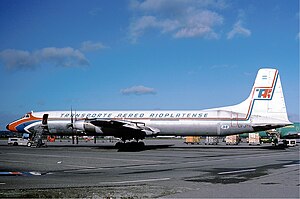Canadair CC-106 Yukon
| CL-44 / CC-106 Yukon | |
|---|---|
 |
|
| A Canadair CL-44 of Transporte Aereo Rioplatense. The same aircraft crashed in July 1981 following a mid-air collision. | |
| Role |
Military transport aircraft Cargo aircraft |
| Manufacturer | Canadair |
| First flight | 16 November 1959 |
| Introduction | 19 July 1960 (RCAF) |
| Retired | 1971 (RCAF) |
| Primary users |
Royal Canadian Air Force Various airlines |
| Number built | 39 |
| Developed from | Bristol Britannia |
| Variants | Conroy Skymonster |
The Canadair CL-44 was a Canadian turboprop airliner and cargo aircraft based on the Bristol Britannia that was developed and produced by Canadair in the late 1950s and early 1960s. Although innovative, only a small number of the aircraft were produced for the Royal Canadian Air Force (RCAF) (as the CC-106 Yukon), and for commercial operators worldwide.
The aircraft is named after the Canadian Yukon territory.
In the 1950s, Canadair had acquired a licence to build the Bristol Britannia airliner. Their first use of the licence was to build the heavily modified Canadair CL-28 Argus patrol aircraft (RCAF designation CP-107) that combined the Britannia's wings and tail sections with a new fuselage and engines. The resulting aircraft had lower speed and altitude, but had two bomb bays and greatly extended loiter times.
With an RCAF requirement for a replacement for its C-54GM North Star (an extensive redesign of the Douglas C-54 Skymaster, that among many changes, was powered by Merlin engines) fleets, Canadair began work on a long range transport primarily intended to provide personnel and logistics support for Canadian Forces in Europe. In January 1957 Canadair received a contract for eight aircraft, later increased to 12. The RCAF designation for the new design was the CC-106 Yukon, while the company's civilian variant was known as the CL-44-6. In company parlance the CL-44 was simply "the Forty-Four."
The RCAF had specified the CL-44 to be equipped with Bristol Orion engines. When the British Ministry of Supply canceled the Orion program, the RCAF revised the specifications to substitute the Rolls-Royce Tyne 11. The CL-44 fuselage was lengthened making it 12 ft 4 in (3.75 m) longer than the Britannia 300 with two large cargo doors added on the port side on some aircraft, while the cabin was pressurised to maintain a cabin altitude of 2,400 m at 9,000 m (30,000 ft). The design used modified CL-28 wings and controls. The Yukon could accommodate 134 passengers and a crew of nine. In the casualty evacuation role it could take 80 patients and a crew of 11.
...
Wikipedia
